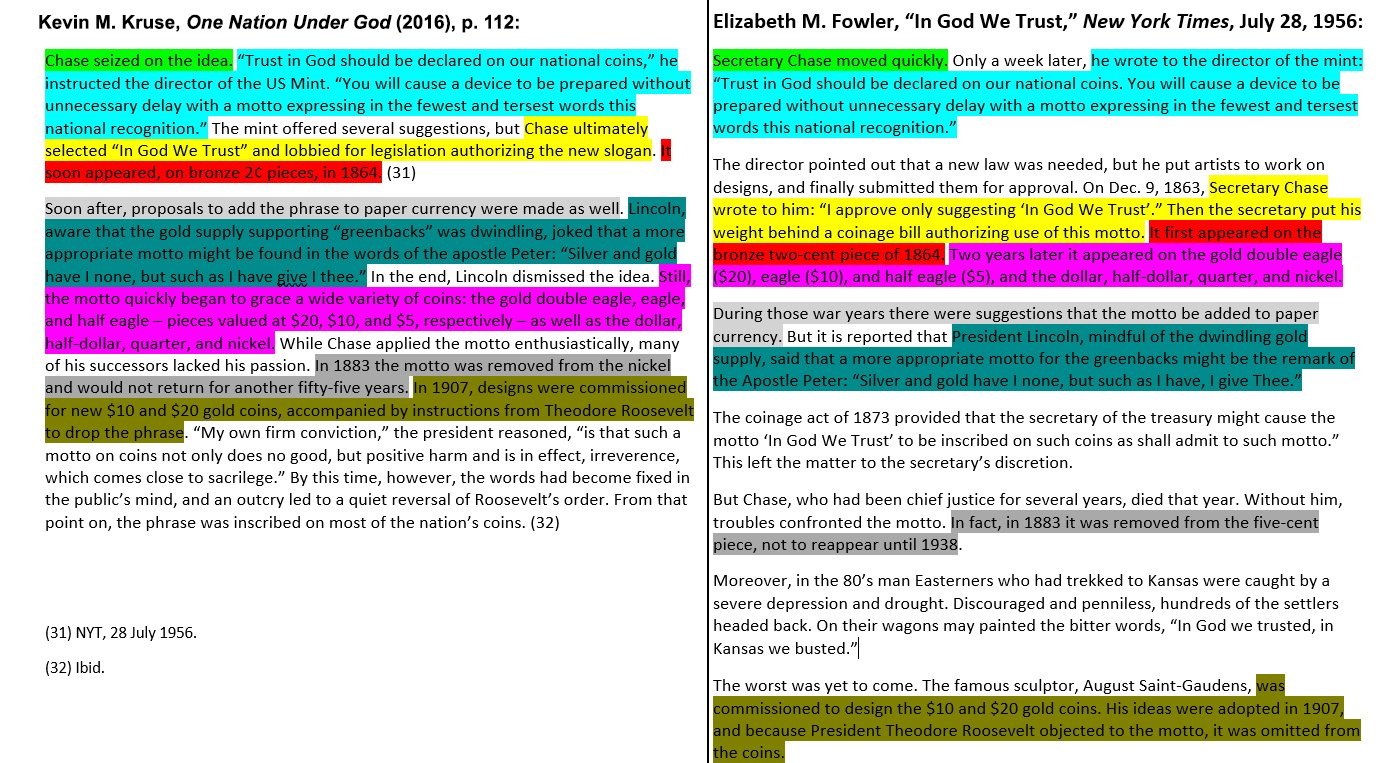Historian Kevin M. Kruse is perhaps best known as a contributor to the New York Times’s controversial 1619 Project, where he wrote an essay linking traffic congestion to the history of segregation. Yet it’s another connection to the New York Times that may put the Princeton University professor under the microscope – specifically his use and misuse of a 1956 article in the newspaper when writing his 2015 book One Nation Under God.
Kruse’s book purports to be a history of its titular phrase, and an accompanying association with public religiosity in the United States. This would not be an unusual subject, except that Kruse advances an unconventional thesis that depicts the Christian imagery of this phrase as well as the United States motto “In God We Trust” as a relatively recent invention, which he then claims is part of a 1950s era backlash against the progressive politics of the New Deal.
I wrote a lengthy review of Kruse’s book in the Independent Review last year, which scrutinizes this thesis and finds it wanting. At the time I was struck by a passage on p. 112 of the book, which appeared to be a hasty insertion about the origin of the “In God We Trust” motto. The motto’s history poses a complication for Kruse’s 1950s-centric thesis, because it originated almost a century prior when it was added to coinage during the Civil War. The passage on p. 112 acknowledges as much but breezes right through this history without accounting for its contradiction of the rest of the book.
When I looked a little closer at Kruse’s text on p. 112, something else jumped out. The language used in several sentences was strikingly similar to another, older source – a July 28, 1956 article on the origin of the “In God We Trust” motto by New York Times reporter Elizabeth Fowler. Kruse’s footnote to the passage cited the date – but not the author or title – of Fowler’s piece. Taken alone, this flawed citation seems fairly minor. But Kruse did more than neglect to credit Fowler for her work. His own text at several points appeared to be a hastily cribbed rewrite of Fowler’s original.
Consider a few of the passages. Here’s Kruse in 2015:
Lincoln, aware that the gold supply supporting “greenbacks” was dwindling, joked that a more appropriate motto might be found in the words of the apostle Peter: “Silver and gold have I none, but such as I have give I thee.”
And here is Fowler’s original:
But it is reported that President Lincoln, mindful of the dwindling gold supply, said that a more appropriate motto for the greenbacks might be the remark of the Apostle Peter: “Silver and gold have I none, but such as I have, I give Thee.”
Kruse again:
It soon appeared, on bronze 2¢ pieces, in 1864.
And Fowler’s original:
It first appeared on the bronze two-cent piece of 1864.
Several other sentences showed similar signs of close cribbing from Fowler’s text, where Kruse simply altered a few words or rearranged the order in which they were presented. Given that he cited the date of his source in a footnote, though not the name or title, Kruse did at least acknowledge where he got the cribbed passages from. But the textual similarities are extensive – indeed, Kruse’s prose resembles something one might expect from a procrastinating undergraduate who’s pulling an all-night session to finish a term paper that’s due the next morning. Instead, it came from a Princeton historian in a widely publicized academic work.

The image above shows the extent of the similarities between Kruse’s passage and Fowler’s original article. Except for a few conveniently omitted details about the Coinage Act of 1873 (another complication for Kruse’s 1950s-centric thesis), Kruse’s passage on p. 112 of his book is essentially a close rewrite of Fowler’s own article.
So what are we to make of this odd discovery? Even the most charitable reading is not pretty for Kruse. Rather than research a series of events that pertained directly to the main thesis of his book, at best he hastily lifted them from a second-hand account. That cribbing was also extremely sloppy in that it never investigated the content it presented, and instead simply rearranged a few words and quotation ordering.
It’s also a fair question to ask whether Kruse committed a more serious offense: plagiarism.
Due to the faulty but existent citation in Kruse’s footnotes, I’d say it’s a borderline case between an embarrassingly sloppy research faux pas and potential research misconduct. But let’s consider how the American Historical Association evaluates similar cases.
The AHA’s website has a detailed description of what qualifies as plagiarism in historical writing. They address what they call subtle forms of plagiarism, as opposed to outright copying-and-pasting of work without credit. Subtle plagiarism might include “an inadequate paraphrase that makes only superficial changes to a text” resulting in “a patchwork of original and plagiarized texts that echoes the original sources in recognizable ways” such as “cosmetic alterations” to the wording or order of the original text.
The AHA also gives an example of a hypothetical case of subtle plagiarism that correctly footnotes the borrowed text’s source, but then proceeds to lift heavily from its wording and structure with only minor cosmetic changes:

In fact, the AHA’s hypothetical example of subtle plagiarism looks strikingly similar to what Kruse did with Fowler’s article on p. 112 of One Nation Under God. It is a complex case that appears to sit right on the boundary between sloppy and egregious. But I’ll leave it to the reader to judge whether Kruse’s text crossed the line into plagiarism, as defined by the AHA guidelines.